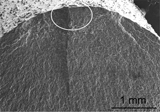Article contents
Effect of pH value on the corrosion and corrosion fatigue behavior of AM60 magnesium alloy
Published online by Cambridge University Press: 11 February 2019
Abstract

To understand the effect of pH value on the corrosion and corrosion fatigue behavior of AM60 magnesium alloy, electrochemical tests, viz., electrochemical impedance spectroscopy (EIS) and fatigue tests, were carried out in PBS (phosphate buffered saline) solutions of pH 5.2, 7.4, and 9.0. The microstructure was investigated by scanning electron microscopy (SEM). Results are as follows: (i) the corrosion mechanism of AM60 under different pH values was different according to EIS; (ii) the corrosion resistance and corrosion fatigue life reduced in the following order: pH 9.0 > pH 7.4 > pH 5.2; (iii) the crack initiation was associated with hydrogen embrittlement of AM60 on the basis of fractographic analysis.
- Type
- Article
- Information
- Copyright
- Copyright © Materials Research Society 2019
References
- 8
- Cited by




